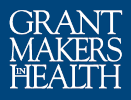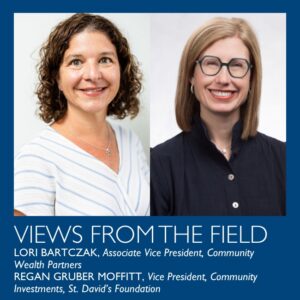Lori Bartczak, Associate Vice President, Community Wealth Partners
Regan Gruber Moffitt, Vice President, Community Investments, St. David’s Foundation
The people closest to the issue best know the solutions. For health funders, sharing power with community could mean giving residents a voice in shaping your grantmaking priorities or where grant dollars are spent.
Many funders understand that solutions are more likely to be successful when the people who are most affected have a voice in shaping them. But when it comes to including that voice, the work often stalls before it starts.
There’s a reason why sharing power with community is not yet standard practice for grantmakers—working this way is complex and requires significant time, resources, and trust. What can grantmakers do to better align their action with their intent?
We explored this with about 90 colleagues at Grantmakers in Health’s 2025 annual conference. Because we know the people closest to the challenges know best the solutions, we wanted to hear from the grantmakers in the room ideas for overcoming four common areas of challenge when it comes to authentically engaging community in the work. Here are the solutions they identified.
Challenge 1: Loss of Control
What if the community wants something we can’t do?
Steps to take:
- Start with internal reflection and assessment. Is your organization truly ready to do this work? Where might internal alignment be needed? What aspects of your culture might need to change in order to partner well with community?
- Engage community members in visioning with boundaries. The onus is on the funder to set clear expectations about what is possible and what might be off the table. Narrowing the group’s focus in this way can help generate stronger ideas.
- Interrogate why you can’t do what the community is asking for. Is it because of legal constraints or self-imposed constraints? Consider whether there might be room for flexibility to meet community needs.
- Counter a “no” with other resources. Consider ways to leverage your connections to help mobilize resources and support from other funders and decision-makers. Engage community members in identifying other alternatives.
- Bring community members into leadership positions in grantmaking organizations. Consider inviting community members to serve on the board or forming an advisory committee of community members. This will help bridge gaps between your organization’s experience and perspective and the community’s experience and perspective, and community members with a deeper understanding of the organization’s priorities and ways of working will be better positioned to offer viable solutions.
Challenge 2: Limited Resources
What if engaging community members requires more time and money than we planned for?
Steps to take:
- Rethink assumptions around resources required. By investing upfront in community engagement you will likely get to effective solutions quicker than you would without deep community engagement.
- Plan for and invest in relationship building and intentional level setting with community members before jumping into a process together. This early investment can help pave the way for smoother work together and potentially avoid unexpected bumps once the work is underway.
- Plan and budget for it. A foundation finance director expressed willingness to partner with program officers to work out compensation for community members, but elevated the importance of being thoughtful and intentional upfront about it.
- Build in flexibility in project plans and budgets. Be open to revising your scope if unexpected needs arise. Consider developing project plans in a phased approach to allow room for reflection and iteration between phases.
Challenge 3: Honoring Expertise
Will we truly learn something new when we listen to community?
Steps to take:
- Recognize that expertise comes in multiple forms. Use a mix of qualitative and quantitative data to help staff and board understand the value of different types of expertise.
- Create opportunities for board members to hear first-hand from community members. Invite community members to board meetings to share their experiences. Hold board meetings in the offices of local nonprofits (and provide compensation for hosting). Help board members understand the value of centering community voice.
- Invest in leadership capacity of community members. Consider the skills and preparation they may need to be effective in board rooms, city hall, or state legislatures. This will help ensure their contributions of knowledge and expertise are having as much impact as possible.
- Take steps to make sure your organization is using accessible language. It will be difficult to learn from community members if you aren’t speaking the same language. The onus is on grantmakers to use language that community members are using and can understand. Work to make language in your strategy, goals, and grant applications straightforward and accessible to community members.
Challenge 4: Lack of Trust
How do we build trust or repair harm?
- Take honest account of your organization’s history with the community. Acknowledge any harm that was caused. Be aware of the bias, privilege, and power your organization holds. Consider what norms your organization may need to unlearn in order to earn trust with community.
- Follow the community’s lead in building trusting relationships. Recognize that this will take time. Continue to show up consistently. Meet them where they are—go to their spaces and events and show up as a listener and supporter.
- Be transparent with community members. When you ask for community input, close loops and share back how that input was used. Let community know the ways in which their input is informing decisions in your organization and/or leading to changes in practice. Communicate how decisions are made and share feedback on why grant proposals were or were not funded.
- Compensate, compensate, compensate! When community members offer their time and wisdom, compensate them. Consider what else they might need to be able to participate in your process—such as support for childcare, transportation, or internet access.
Centering community perspective in grantmaking can feel challenging because, for many grantmaking organizations, it requires a fundamentally different approach from traditional forms of philanthropy that are steeped in transactional, white-dominant behaviors. Based on our session at the 2025 Grantmakers in Health conference, we realize we are still on a learning journey in terms of what to do and what not to do. By continuing to learn together with peers and try new ways of working, we hope to see a future where centering community is the default for philanthropy.

